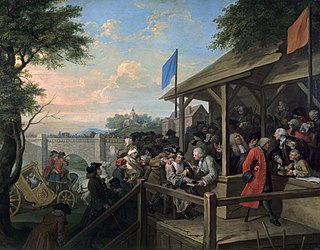
The flag of Europe or the European flag is an official symbol used by two separate organisations, the Council of Europe (CoE) - as a symbol representing Europe, and the European Union (EU). It consists of a circle of twelve five-pointed golden stars on a blue field.

Orange is the colour between yellow and red on the spectrum of visible light. Human eyes perceive orange when observing light with a dominant wavelength between roughly 585 and 620 nanometres. In painting and traditional colour theory, it is a secondary colour of pigments, created by mixing yellow and red. In the RGB color model, it is a tertiary colour. It is named after the fruit of the same name.

The flag of Finland, also called Siniristilippu, dates from the beginning of the 20th century. On a white background, it features a blue Nordic cross, which represents Christianity.

The flag of Brazil, known in Portuguese as Verde e amarela, or less usually Auriverde, is a blue disc depicting a starry sky spanned by a curved band inscribed with the national motto "Ordem e Progresso", within a yellow rhombus, on a green field. Brazil officially adopted this design for its national flag on November 19, 1889 — four days after the Proclamation of the Republic, to replace the flag of the Empire of Brazil. The concept was the work of Raimundo Teixeira Mendes, with the collaboration of Miguel Lemos, Manuel Pereira Reis and Décio Villares.

The flag of Malaysia, also known as Malay: Jalur Gemilang, is composed of a field of 14 alternating red and white stripes along the fly and a blue canton bearing a crescent and a 14-point star known as the Bintang Persekutuan. The 14 stripes, of equal width, represent the equal status in the federation of the 13 member states and the federal territories, while the 14 points of the star represent the unity between these entities. The crescent represents Islam, the country's state religion; the blue canton symbolises the unity of the Malaysian people; the yellow of the star and crescent is the royal colour of the Malay rulers.

The flag of Bosnia and Herzegovina contains a wide medium blue vertical band on the fly side with a yellow right triangle abutting the band and the top of the flag. The remainder of the flag is medium blue with seven full five-pointed white stars and two half stars top and bottom along the hypotenuse of the triangle.

Political colours are colours used to represent a political ideology, movement or party, either officially or unofficially. It is the intersection of colour symbolism and political symbolism.

The national flag of Cape Verde was adopted on 22 September 1992, replacing the flag adopted during Cape Verdean independence, fought for with Guinea-Bissau, another former Portuguese colony on mainland West Africa.

The state emblem of Azerbaijan mixes traditional and modern symbols. The focal point of the emblem is a stylized flame. The flame is in the shape of the word "Allah" written in Arabic to represent the country's majority-Muslim population. As well as a reference to Azerbaijan's eternal natural oil-gas resources, which has given it the nickname "land of eternal fire".

The national flag of Ecuador, which consists of horizontal bands of yellow, blue and red, was first adopted by law in 1835 and later on 26 September 1860. The design of the current flag was finalized in 1900 with the addition of the coat of arms in the center of the flag. Before using the yellow, blue and red tricolor, Ecuador used white and blue flags that contained stars for each province of the country. The design of the flag is very similar to those of Colombia and Venezuela, which are also former constituent territories of Gran Colombia. All three are based on a proposal by Venezuelan General Francisco de Miranda, which was adopted by Venezuela in 1811 and later Gran Colombia with some modifications. There is a variant of the flag that does not contain the coat of arms that is used by the merchant marine. This flag matches Colombia's in every aspect, but Colombia uses a different design when her merchant marine ships are at sail. Along with Haiti, Afghanistan, Bolivia, Costa Rica, the Dominican Republic, El Salvador, and Venezuela, it is one of only eight national flags whose design incorporates a depiction of the flag itself.

The flag of the United Nations was adopted on December 7, 1946, and consists of the official emblem of the United Nations in white on a blue background.

The Olympic symbols are icons, flags and symbols used by the International Olympic Committee (IOC) to elevate the Olympic Games. Some—such as the flame, fanfare and theme—are more commonly used during Olympic competition, but others, such as the flags, can be seen throughout the years. The Olympic flag was created under the guidance of Baron de Coubertin in 1913 and was released in 1914. It was first hoisted in 1920 in Antwerp, Belgium at the 1920 Summer Olympics in the main stadium. The five rings represent the five continents of the world.

In military organizations, the practice of carrying colours, standards or guidons, both to act as a rallying point for troops and to mark the location of the commander, is thought to have originated in Ancient Egypt some 5,000 years ago. The Roman Empire also made battle standards a part of their vast armies. It was formalized in the armies of Europe in the High Middle Ages, with standards being emblazoned with the commander's coat of arms.

The 1995 Southeast Asian Games, officially known as the 18th Southeast Asian Games, was a Southeast Asian multi-sport event held in Chiang Mai, Thailand from 9 to 17 December 1995. It was the first time that a non-capital city hosted the biennial sports event. Chiang Mai is the second Thai city to host the Southeast Asian Games after Bangkok. The games were opened and closed by Vajiralongkorn, the then-Crown Prince of Thailand. With the return of Cambodia, all ten members of the federation were present to compete in the SEA Games for the first time.

The 2007 Southeast Asian Games, officially known as the 24th Southeast Asian Games, was a Southeast Asian multi-sport event held in Nakhon Ratchasima (Korat), Thailand. This was the sixth time Thailand hosted the Southeast Asian Games and its first time since 1995. Previously, Thailand also hosted the 1959 inaugural games, 1967 games, 1975 games and the 1985 games.

The air forces of the United Kingdom – the Royal Navy's Fleet Air Arm, the Army's Army Air Corps and the Royal Air Force use a roundel, a circular identification mark, painted on aircraft to identify them to other aircraft and ground forces. In one form or another, it has been used on British military aircraft from 1915 to the present.

The Flag of Malacca is the flag of the Malaysian state of Malacca. Red, white, yellow and blue, which are the colours of the flag of Malaysia, are also used in the flag of Malacca to emphasize that Malacca is a member state of Malaysia. The star and crescent represents Islam, the official religion of the State and of the nation. The top left hand quarter has a background of royal blue with a yellow crescent moon and a yellow five-pointed star. The top right hand quarter is red and the lower half is white.

The Emblem of the Association of Southeast Asian Nations is the emblem of ASEAN adopted in July 1997 together with the ASEAN flag. Although the current emblem was already in use for years, the official guidelines were adopted at the 6th Meeting of the ASEAN Coordinating Council (ACC) in Hanoi, 8 April 2010.

The 2016 ASEAN University Games, officially known as the 18th ASEAN University Games, was a Southeast Asian university multi-sports event held in Singapore. This was the third time Singapore hosted the ASEAN University Games, and its first time since 1994. Previously, Singapore also hosted the 1986 games.

The 2008 ASEAN University Games, officially known as the 14th ASEAN University Games, was a Southeast Asian university multi-sport event held in Kuala Lumpur, Malaysia from 11 to 21 December 2008. This was the third time Malaysia hosted the games after 1984 and 1993.





















